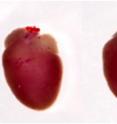Just in time for Valentine's Day: UNC researchers identify a gene critical for heart function
Related images
(click to enlarge)
Everyone knows chocolate is critical to a happy Valentine's Day. Now scientists are one step closer to knowing what makes a heart happy the rest of the year. It's a gene called DOT1L, and if you don't have enough of the DOT1L enzyme, you could be at risk for some types of heart disease. These findings from a study led by researchers at the University of North Carolina at Chapel Hill School of Medicine appear in the Feb. 1, 2011 issue of the journal Genes and Development.
The team created a special line of mice that were genetically predisposed to dilated cardiomyopathy, a condition in which the heart expands like a balloon, causing its walls to thin and its pumping ability to weaken. About one in three cases of congestive heart failure is due to dilated cardiomyopathy, a condition that also occurs in children.
These mice lack DOT1L. The big discovery came when the researchers were able to prevent the mice from developing the disease by re-expressing a single downstream target gene, Dystrophin.
"We saw this phenotype in the heart and it could be attributed to anywhere between 1 and 1,000 genes. But when we just added back this one gene, the heart function was completely rescued," said the study's lead author, Anh Nguyen, a graduate student in the lab of biochemist Yi Zhang, PhD, at UNC's Lineberger Comprehensive Cancer Center. "It was very surprising to us," Nguyen added. "Normally you'd think you'd have to add in a number of genes to really see that effect."
The researchers discovered that the gene depends on the enzyme DOT1L to activate it. If DOT1L levels fall too low, Dystrophin ceases to perform its function, eventually leading to heart disease.
"We've identified a new function of DOT1L, which has been linked to leukemia before, but never linked to heart defects," said Zhang, Kenan Distinguished Professor of biochemistry and biophysics and an Investigator of the Howard Hughes Medical Institute.
Learning how the DOT1L affects Dystrophin could eventually help to improve diagnosis and treatment of patients with dilated cardiomyopathy and other conditions. "The more we know about the protein, the better we can use it," Zhang said.
The protein could be a target for gene therapy, for example. "If you could manipulate the function of DOT1L, then you could essentially regulate everything else downstream, including Dystrophin or other genes," explained Nguyen.
In addition to their experiments using mice, the team examined samples of human heart tissue. Patients with dilated cardiomyopathy had lower levels of DOT1L than patients with no underlying heart condition, suggesting that the protein's role in humans is similar to its role in mice.
The findings also have potential relevance for Duchenne muscular dystrophy, which is caused by defects in Dystrophin function. About 90% of people with muscular dystrophy develop dilated cardiomyopathy; this study suggests perhaps low levels of DOT1L could be a common factor in both conditions.
Source: University of North Carolina School of Medicine
Other sources
- Gene critical for heart function identifiedfrom Science DailyFri, 4 Feb 2011, 19:32:13 UTC
- Just in time for Valentine’s Day: UNC researchers identify a gene critical for heart functionfrom Science BlogFri, 4 Feb 2011, 17:30:51 UTC
- Just in time for Valentine's Day: Researchers identify a gene critical for heart functionfrom PhysorgFri, 4 Feb 2011, 17:01:49 UTC
